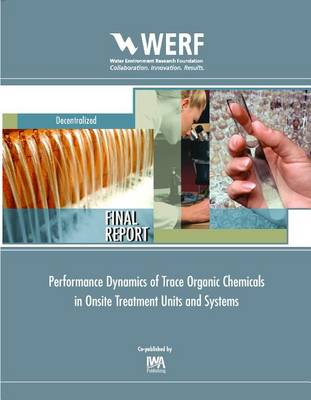WERF Research Report
2 total works
Of the total number of consumer product chemicals the U.S. Environmental Protection Agency has identified, approximately 500 are considered high production volume (HPV) chemicals. This study investigated the occurrence and fate of high production volume household chemicals in wastewater systems. The study was initiated with a comprehensive review on HPV organic chemicals in household commodities and their contributions to municipal wastewater treatment systems. The comprehensive review presented the basis to compile a database on HPV chemicals and organic compounds in household commodities that have the potential to affect wastewater processes and effluent qualities. The occurrence of select HPV target compounds during wastewater treatment was studied by collecting composite samples of raw sewage and final treated effluents at seven full-scale treatment plants employing different operational conditions.
Of the 26 household chemicals targeted in this study, 20 compounds were consistently detected in raw influents of full-scale wastewater treatment plants. Chemicals that are primarily used in products applied outdoors were generally not present in raw influent samples. The majority of compounds present in personal care and cleaning products generally appeared in all influent samples with concentrations of 2-phenoxyethanol (a preservative with various uses) and menthol (a fragrance with various uses) consistently exhibiting the highest concentrations of all compounds. The efficacy of advanced wastewater treatment processes to achieve removal and destruction of selected target compounds was studied through controlled lab- and pilot-scale studies (i.e., MBR, ozone, AOP). In general, biological treatment resulted in partial or complete removal (>80%) indicating that biological treatment is a good treatment option for HPV household chemicals.
Of the 26 household chemicals targeted in this study, 20 compounds were consistently detected in raw influents of full-scale wastewater treatment plants. Chemicals that are primarily used in products applied outdoors were generally not present in raw influent samples. The majority of compounds present in personal care and cleaning products generally appeared in all influent samples with concentrations of 2-phenoxyethanol (a preservative with various uses) and menthol (a fragrance with various uses) consistently exhibiting the highest concentrations of all compounds. The efficacy of advanced wastewater treatment processes to achieve removal and destruction of selected target compounds was studied through controlled lab- and pilot-scale studies (i.e., MBR, ozone, AOP). In general, biological treatment resulted in partial or complete removal (>80%) indicating that biological treatment is a good treatment option for HPV household chemicals.
Performance Dynamics of Trace Organic Chemicals in Onsite Treatment Units and Systems
by Joerg E. Drewes
Published 15 December 2011
Available as an eBook only.
The purpose of this work is to improve our understanding regarding presence and attenuation of TOrC in onsite wastewater systems. A full-scale septic tank and sequencing batch membrane bioreactor (SBMBR) were used to provide water for the experiments conducted. Bench-scale soil columns were used to simulate the performance of soil absorption systems. Effluent from both STE and SBMBR were used in soil column experiments.
The objectives of this study were to investigate the fate and occurrence of trace organic contaminants (TOrC) in Onsite Wastewater Systems (OWS). The data collected over the course of this study highlighted the lack of detailed TOrC occurrence data for onsite systems. As such a more robust sampling campaign was completed to characterize the occurrence and standard deviation of TOrC occurrence in septic tank effluents (STE). These results were compared with the variability of TOrC occurrence in advanced above ground treatment effluent. The main objective of the study was to detail the role of the quantity and type of organic matter in infiltrating water on the attenuation of TOrC. The rate at which water is applied to the subsurface may be important in the performance of soil absorption systems. The analytical methods and experimental approach used for this study are presented in Chapter 2.0. The occurrence of TOrC in septic tanks serving different unique sewersheds and above ground treatment steps are detailed in Chapter 3. Chapter 4 discusses the role of soil absorption systems on further treatment of TOrC in OWS, specifically the role of loading rate and the amount and type of organic carbon present in infiltrating water. Finally some conclusions and recommendations for future work are presented.
The purpose of this work is to improve our understanding regarding presence and attenuation of TOrC in onsite wastewater systems. A full-scale septic tank and sequencing batch membrane bioreactor (SBMBR) were used to provide water for the experiments conducted. Bench-scale soil columns were used to simulate the performance of soil absorption systems. Effluent from both STE and SBMBR were used in soil column experiments.
The objectives of this study were to investigate the fate and occurrence of trace organic contaminants (TOrC) in Onsite Wastewater Systems (OWS). The data collected over the course of this study highlighted the lack of detailed TOrC occurrence data for onsite systems. As such a more robust sampling campaign was completed to characterize the occurrence and standard deviation of TOrC occurrence in septic tank effluents (STE). These results were compared with the variability of TOrC occurrence in advanced above ground treatment effluent. The main objective of the study was to detail the role of the quantity and type of organic matter in infiltrating water on the attenuation of TOrC. The rate at which water is applied to the subsurface may be important in the performance of soil absorption systems. The analytical methods and experimental approach used for this study are presented in Chapter 2.0. The occurrence of TOrC in septic tanks serving different unique sewersheds and above ground treatment steps are detailed in Chapter 3. Chapter 4 discusses the role of soil absorption systems on further treatment of TOrC in OWS, specifically the role of loading rate and the amount and type of organic carbon present in infiltrating water. Finally some conclusions and recommendations for future work are presented.

